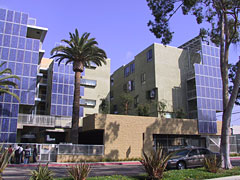
Green Building
|
It used to be that no one could agree on exactly what "green building" was. Depending on who you talked to, a green building could be anything from an office building with fluorescent lights to a shack in the woods with a composting toilet.
That confusion is starting to clear up a building rating system devised by the U.S. Green Building Council Leadership in Energy and Environmental Design (LEED). The USGBC is a coalition of representatives from the building industry who have joined together to promote environmentally-friendly construction.
The LEED 2.0 standard came out in 2001 and is already a major force in the design community. A building is assigned a number of points based on how well it meets standardsfor water savings, energy efficiency, eco-friendly materials, indoor environmental quality and other criteria. Qualifying buildings may be designated Certified, Silver, Gold or Platinum, depending on the number of points awarded.
The process strongly encourages designers to plan green elements long before construction begins. Currently only commercial and institutional buildings are eligible, not single-family residences.
 Colorado Court, a green apartment building in Santa Monica |
Many planners and architects say the LEED standard, combined with improved technology and thinking about green building early in the design process, has made it much easier and cheaper to build green. Any extra initial building costs are often recouped over the life of the building in lower energy bills.
"It would have been a much more arduous process for L.A. to adopt a green building standard if we had to develop one ourselves," said Deborah Weintraub, City Architect of Los Angeles. "It was relatively simple to go to council and say, other cities are using this."
Walker Wells, of Global Green, the US affiliate of the Green Cross environmental organization, says that the LEED system may allow Southern California to get the edge on Northern California in green building.
“Sure, in the Bay Area there are many more houses built green, with passive solar and drums of rain water in the backyard,” said Wells. “That culture that happened on the north coast never happened out in the desert here. Now with LEED we’re going to have all these buildings, what are going to be big projects down here… if you look at what’s going to be built pretty soon and you add up the millions of dollars, it’s almost $3 billion worth of green construction. The city of L.A. is going to build more buildings in the next ten years than all of San Francisco, Oakland and San Jose combined. I think you could make the case that Southern California as a region is ahead of the curve, mainly because of these three huge public agencies that have made policy commitments.”
Those agencies are the Los Angeles Unified School District, the Los Angeles Community College District, and the city of L.A., the three 500-pound gorillas of Los Angeles public building projects.
